November 2013 Archives
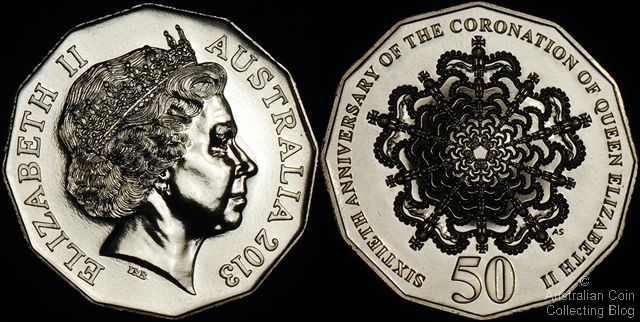
Queen's Coronation 50 Cent -the 60th Anniversary
Whether you're a monarchist or a republican, you can't have missed celebrations for the Diamond Jubilee of Queen Elizabeth II - the 60th Anniversary of a young newly married 25 year old princess, ascending to the throne after the death of her father, King George VI on 6 February 1952. It took over a year for Princess Elizabeth to be crowned Queen on 2 June 1953. British tradition dictated the coronation be delayed as it was considered inappropriate to celebrate the crowning of a new monarch within the mourning period for King George VI. This 50 cent celebrates her 60 years as the crowned monarch.
60 years - a Diamond Jubilee. What an achievement to have been doing the same work for 6 decades! To mark this auspicious occasion, the Royal Australian Mint has released a dodecagonal 50c coin design available in uncirculated and proof finish for the collector market (not for circulation).
At the time of her crowning, Queen Elizabeth II reigned over 16 sovereign states, 12 of which were British colonies (also called Dominions). The only other monarch to have celebrated a Diamond Jubilee is Queen Victoria in 1897. Another achievement is that Queen Elizabeth II is the oldest monarch to have celebrated a Golden Jubilee with James I (James VI of Scotland) being the youngest aged 51. For this occasion back in 2003 the Mint issued a golden aluminium bronze 50 cent.
During the Jubilee celebrations, the Queen and her husband Prince Philip, Duke of Edinburgh, remained within the United Kingdom, mainly due to the Prince's ill-health. So the task of traveling around the Commonwealth of Nations was handed over to other members of the Royal Family. The Queen's eldest son and heir to the throne, Charles the Prince of Wales and his wife Camilla, the Duchess of Cornwall visited Canada, Papua New Guinea, New Zealand and Australia. Her youngest son, Prince Edward the Earl of Wessex and his wife Sophie, the Countess of Wessex visited Saint Lucia, Barbados, Saint Vincent and the Grenadines, Antigua and Barbuda, Grenada, and Saint Kitts and Nevis. Her grandsons Prince William and Prince Harry also did their bit - Prince William, the Duke of Cambridge and his wife Catherine, the Duchess of Cambridge visited the Solomon Islands and Tuvalu; whilst Prince Harry visited the Bahamas, Belize, and Jamaica. It was also in the Queen's 60th year that it was prematurely revealed that Prince William and new wife Kate were expecting the next heir and the Queen's Great Grandchild Prince George, also the subject of another 50 cent.
The organizational infrastructure surrounding the Diamond Jubilee was immense - it is estimated to have cost more than ₤1.3 billion in Britain alone ... with activities ranging from an equestrian pageant with 500 horses flown in from around the world, through to flying in performers from 16 countries. Then there was the centrepiece event of the Thames River Pageant where flotilla's of ships were presented to the Queen, through to a concert staged outside Buckingham Palace, even a 5 day Bank Holiday week bestowed to the British public, and many more side events too numerous to mention.
The Queen also sent during her Diamond Jubilee celebrations over 540,000 telegrams to United Kingdom and Commonwealth couples who were celebrating diamond wedding anniversaries (60 years of marriage) themselves.
Not to be confused this 50 cent celebrates 60 years since Queen Elizabeth II was crowned at the Coronation ceremony in 1953. Her Majesty ascended the throne in 1952 and 60 years as Queen the diamond jubilee was also celebrated with two 2012 dated 50c coins, one by Michael Meszaros featuring a diamond and a sprig of wattle and a coin featuring fireworks and a single St Edwards Crown. Numerous coins and medals from other Commonwealth countries were also minted for this milestone.
This 2013 50c Coronation 60th Anniversary coin, with a depiction of 60 Coronation (St Edwards) crowns was design by the Royal Australian Mints Aleksandra Stokic. The obverse mature portrait of Queen Elizabeth II is designed by Ian Rank-Broadley, It is released in silver proof, also in uncirculated copper-nickel in a collector card and in a prestige stamp and coin booklet.
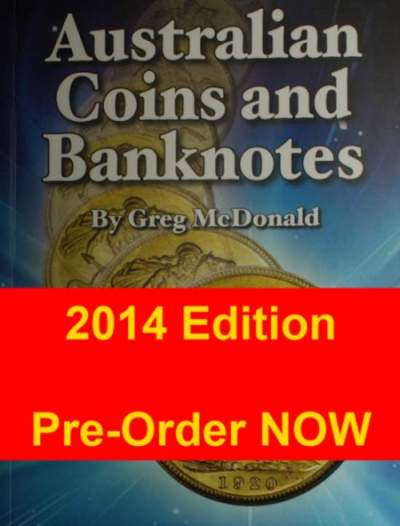
If you know what we're talking about then you're a hardcore coin collector because this coin catalogue is known as the bible of Australian coin collecting. Even for the amateur this handy reference can be found in local public libraries and is essential to looking up the who what where when of coin issues by the Royal Australian Mint and the Perth Mint. This catalogue is found in every Australian coin collectors library and is routinely carried to coin shows and coin shops.
The 2014 (21st edition) is being shipped to Australia from Singapore as we write this and is expected to be in dealer hands the second week of December. This is the first issue to be printed offshore to the disapointment of the author. Nevertheless the latest Macca's should be in collector hands by Christmas. This issue is Greg's 26th publication in 31 years and he's the founder of the Australasian Coin and Banknote Magazine.
If you're thinking of picking up a copy of the latest Australian Coins and Banknotes we have committed to purchasing a bulk number of books offered at a discount to the retail price of $39.95. If you wish to pre-order a book for $35 delivered to your Australian address please head over to The Purple Penny webshop. Pre-purchase and pre-pay so we can have your new book in the mail the day after we receive them and in your Christmas stocking soon!

2013 Dollar Coins
The annual report for the Royal Australian Mint was made public just a few days ago. This means we can embark on the task of updating mintage numbers and begin to get an idea of the real production of Australian coins for both circulation and non-circulating legal tender. Coins are often released with mintage numbers printed on a certificate of authenticity or on the packaging but this doesn't always reflect the demand for that issue with batches of coins often being minted on demand throughout the year. This mintage number is often the maximum number of coins that the Mint will make of this type. Absolute final mintage numbers for particular issues can often be found within 2 or more annual reports spanning the financial year 1 July to 30 June.
The Mint annual report is a 123 page document with the appendices containing the circulating coin production numbers and collector coin release summaries. It's a daunting task to match up RAM product codes with what we know was released throughout the year.
It appears we've now finalised the numbers for 2010 with more mob of roos dollars minted for circulation in the 2012-2013 fiscal year. It also appears that we have no one dollar coins minted for circulation in 2012. A mint set only year of issue. The 2011, 2012 and 2013 mintage numbers have also now been updated with the latest data.
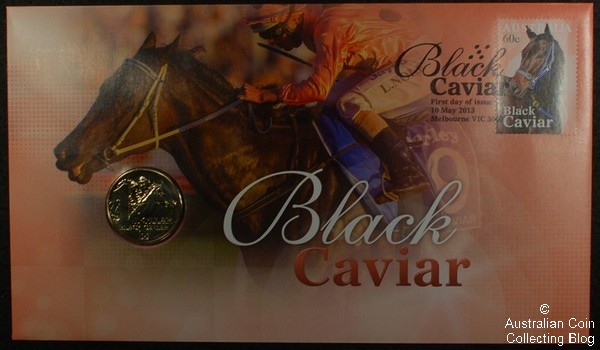
Black Caviar PNC
Were you swept up in the national hysteria that surrounded Black Caviar? Were you fortunate enough to have seen her race? And if you did, were you absolutely awestruck at the magnificence of the horse?
Imagine for a minute the slow-motion video footage of that last race ..............
the crashing and banging of barriers when the horses set off for the finish line, the thundering sound of hooves pounding around the racecourse, horse's grunting and snorting, muscles rippling, sweat droplets glistening in the mid afternoon sun, the tight bunchedness as positions are fought for, jockeys raising themselves higher and higher in their saddles, the echo of a rapturous crowd as Black Caviar starts to pull in front, the race commentator's fevered excitement within his voice with his pitch getting higher and higher till he's almost screaming, the thunderous applause and cheering as Black Caviar crosses the line .....
Named as Australian Champion Sprinter and Australian Horse of the Year in 2011 and 2012; World Champion Sprinter in 2010, 2011 and 2012; inducted into the Australian Racing Hall of Fame in 2013; and undefeated over 25 races earning more than A$8 million, Black Caviar was retired in April 2013 - and we'll probably never see the likes of such a horse again. All Australians were exceptionally fortunate to have witnessed history in the making.
Here's a few unusual facts about Black Caviar that you might not have previously known:
Black Caviar's beautiful to look at - sturdy, rippling muscles, beautifully proportioned - but weighs around an astonishing 600 kg.
Her stable name is plain and simple "Nelly" with her racing name bestowed by part-owner Pam Hawkes, who loves to eat black caviar. Black Caviar's racing colours of salmon pink and black dots symbolise caviar.
Black Caviar's 25 undefeated race record is the longest standing world record for more than 100 years, with Kincsem, an Hungarian mare racing in 1870, doing a fair bit better with 54 undefeated races.
Her winnings of more than AUD$8 million amounts to approximately AUD$318,253 per race or an amazing AUD$4,758 per second !
If you're overwhelmed with a sense of loss on Black Caviar's retirement, fear not - the Royal Australian Mint and Australia Post have come to the rescue, releasing a specially minted commemorative coin in a PNC (philatelic numismatic cover) to celebrate her extraordinary career. The PNC incorporates a 60c stamp and a $1.00 aluminium bronze alloy uncirculated coin - 25 millimetre diameter and weighing 9 grams.
This coin is most commonly found in this PNC but has been included in limited edition specially framed sets* (mintage of 1,000). A pad-printed **coloured version can be purchased in a collector card.
If the slow-motion video footage described above is still playing in your head, the reverse "true to life" artistic rendition by designer Tony Dean of Black Caviar and her jockey pounding on through to the finish line, will surely delight. The coin and PNC cover depicts Black Caviar as we've all come to recognize her - in full stride. The coin's obverse depicts the portrait of Queen Elizabeth II by Ian Rank-Broadley.
The PNC Black Caviar commemorative Stamp and Coin Cover is issued at $19.95. For the latest mintage information see the 2013 1 Dollar issues and mintages table.
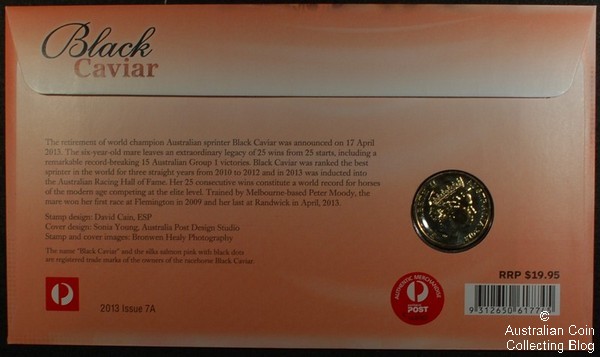
Black Caviar PNC
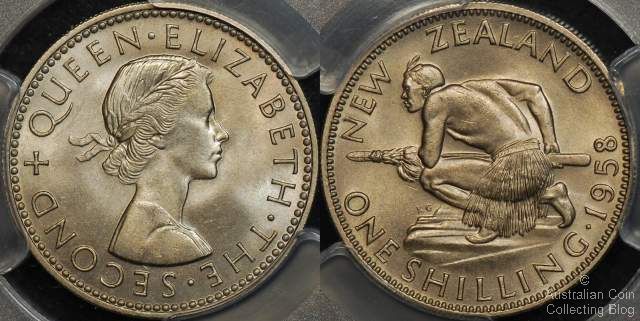
New Zealand 1958 Broken Back Shilling
Identifying the broken back variety New Zealand pre-decimal shilling can be difficult if you don't know what you're looking for. This die variety occurs in the 1942, 1958 and 1965 strikings of the shilling, here's what to look out for.
The New Zealand shilling reverse features a crouching Maori (sculpted by George Kruger Gray) in traditional dress, shirtless with a piupiu or grass skirt. At the bottom of the warrior's back to the right of his spine where it meets his clothing the broken back variety shows a lack of detail with a smooth flattened area between his back and his skirt. This is clearly shown in the comparison image below. It's very easy to see when you have a normal coin to compare that his back doesn't touch his waist. The New Zealand catalogue suggests this variety is due to die degradation or die fill but we're unable to comment on the accuracy of this. We'd need to see a number of coins of the same type from the same year to see if there is any progression of the variety during the life of the die. Best we can say right now is that the variety could be due to die degradation or fill OR could be a legitimate die variety.
This back/belt break is shown above on the 1958 shilling. There were 1,000,000 1958 shillings minted at the Royal Mint in London and released into circulation in New Zealand. Of this 1 million mintage perhaps 50,000-60,000 of the broken back variety exist suggesting one die used had the different detail in the reverse.
John Bertrand's New Zealand Coin and Banknote catalogue (2013 edition) estimates that the 1942 dated broken back shilling could have a mintage of 80,000 of the total 240,000 struck for that year. The 1965 examples are included in the total mintage of 3,500,000 and the population of the broken back variety for that year is not known.
The 1942 shillings were minted in 50% silver but the 1958 and 1965 coins are copper-nickel and can display a lovely tone. Each weighs 5.65 grams and are 23.62 millimetres in diameter with edge milling.
If these types of New Zealand varieties interest you then you should be on the lookout for the broken wing sixpence, round back vs flat back Kiwi on florins, no shoulder strap QE2 portraits and that's just the pre-decimals!
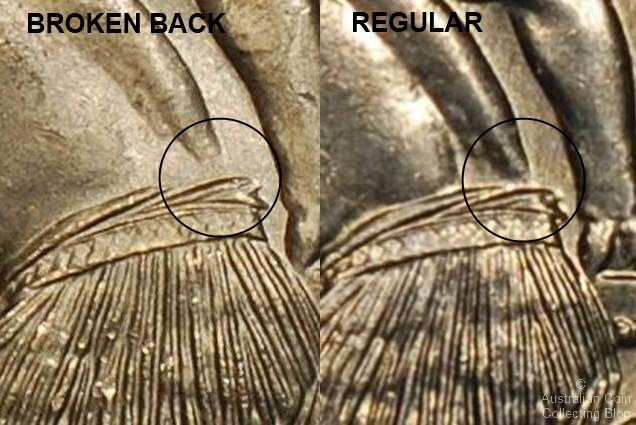
Comparison Image
Roger McNeice, a well known Tasmanian numismatist is releasing a new book on Tasmanian colonial coins entitled "Colonial Coins of Tasmania". It's available at pre-release pricing of $15 a copy direct from the author (rvm@eftel.net.au). If you're interested in colonial or proclamation coins then this would be a great addition to your library.
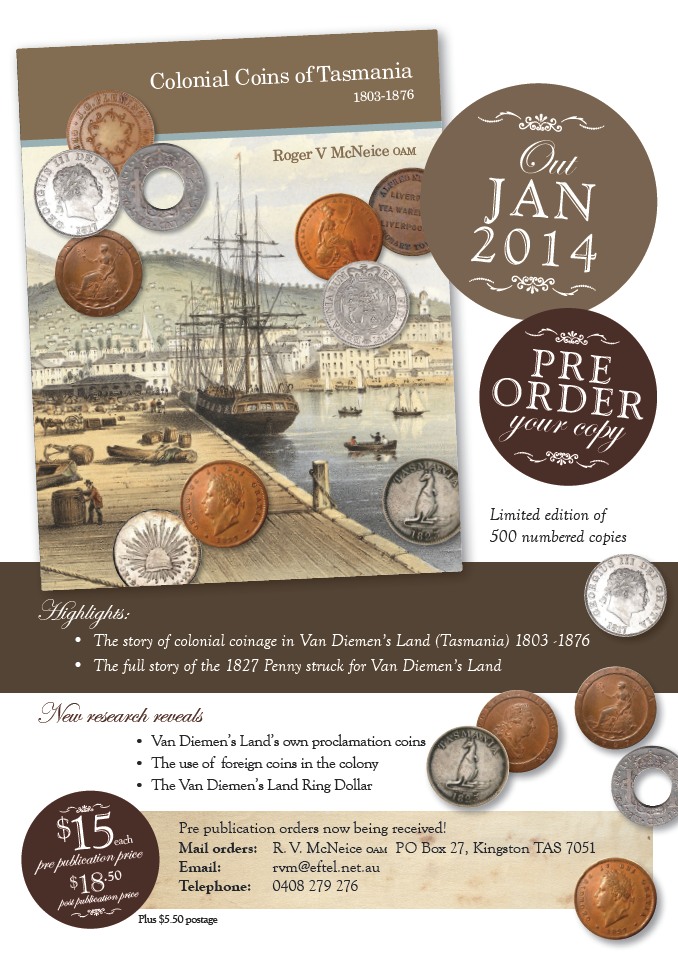
Mints around the world make mistakes, it's more common than you might think. And sometimes very embarrassing. It could be a technical error, a mixup with die pairing or a very embarrassing spelling error.
Recently coming to light is an embarrassing spelling errors when the Vatican (struck by the Italian State Mint) struck and released a medal commemorating the first year of reign for Pope Francis, misspelling Jesus as Lesus. Almost all of these medals were recalled once the error was noticed but a few remain in collector hands selling for thousands of dollars. In a similar vein in 1854 some British halfpennies bore the inscription for the Queen Victoria, the V wasn't a letter V at all but an inverted A.
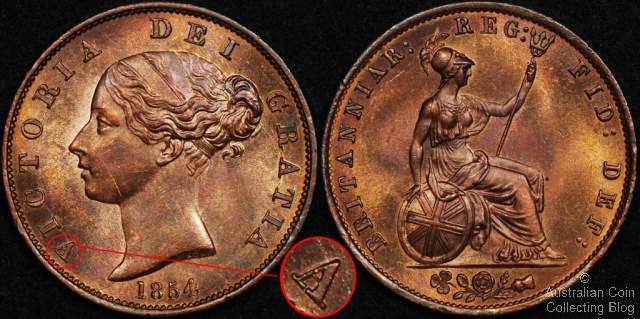
British 1854 Halfpenny with inverted A instead of V for Queen Victoria
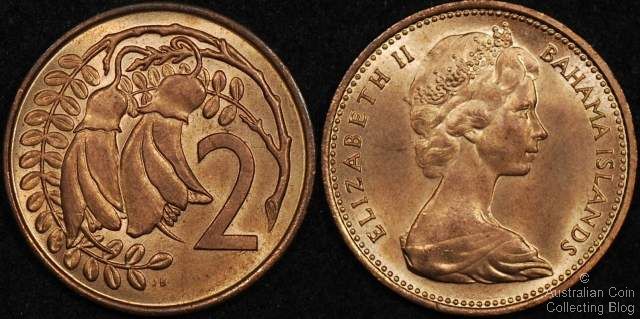
1967 (left) New Zealand new 2 Cent reverse, (right) Bahama Islands 5 cent obverse
In Australian circulating currency another type of mule springs to mind as the biggest 'whoops' made by the Royal Australian Mint. In the year 2000 the mob of roos 1 dollar coin minted for circulation was accidently struck with the wrong obverse. Only slightly smaller in diameter the 10 cent coin obverse was used on the wrong coin and it certainly stands out in the crowd.
Mistakes such as these easily stand out but other errors are not so easy to spot.
Pick up a coin from your wallet, hold it queens side facing you by the edges between your thumb and forefinger. Spin it around. Is the design still upright? If it's not then you've found an upset where one of the dies has rotated out of alignment during the production run or been incorrectly fitted in the press. The 2001 Centenary of Federation dollar is one such example that can be found in varying degrees of rotation - actually in every degree of the clock face!
Sovereigns were struck with the obverse seemingly upside down but just like US coins this is known as coin die alignment (or coin orientation) and is how they should be struck. There are just 2 known examples of the 1872 Melbourne shield sovereign being struck at a 180 degree rotation from normal (medallic alignment) which has been done in error. Eric from Drake Sterling Numismatics has written an interesting article about this error sovereign well worth reading.
If you're a keen error collector you'll always be looking out for coins that seem just not quite right....you'll know them when you see them. Don't forget that we've written about many different types of mistakes made by various mints (but in particularly the Australian mints). You should take a look at our error coin archives if you wanted to read more.
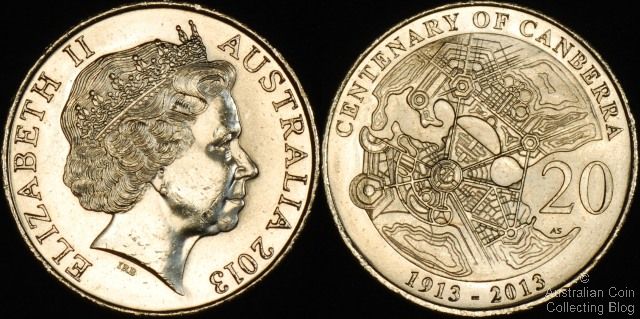
2013 Circulation 20 Cent Canberra Centenary
How many 20 cent coins do you have in your wallet or purse right now? Go on - have a look. Does your 20c coin show the 1913 blueprint of our nation's capital Canberra, designed by Walter Burley Griffin and his wife Marion? If it does, congratulations - you're the owner of one of the Royal Australian Mint's 5 million 20c coins released into circulation to celebrate Canberra's centenary. Yes, that's right - Canberra turned 100 on 12th March 2013 and throughout the entire year special events have been organized to showcase Canberra and it's role in our national history. This included "One Very Big Day" celebrations on a special public holiday March 11th where you could swap a 20c from your pocket for a new shiny Centenary of Canberra commemorative 20 cent at the RAM tent by Lake Burley Griffin.
But all's not lost if you've not yet seen the specially minted commemorative Centenary of Canberra 20c circulating coin, as Australia Post have released a PNC (philatelic numismatic cover) Stamp and Coin cover, incorporating the commemorative 20 cent coin and 2 commemorative stamps - a 60c stamp and an International $2.35 stamp, both designed by Melbourne-based Mary Callahan Design. Each stamp depicts Canberra's iconic streetscape blueprint and two of the capital's most prominent buildings - the 60c stamp portrays the National Portrait Gallery and the $2.35 stamp portrays Parliament House.
Imagine the celebrations on Capital Hill in Canberra on 12th March 1913 and how different it was compared to our celebrations of today. The official "naming of Canberra" ceremony photograph (gracing the PNC Stamp and Coin cover envelope) shows just how auspicious an occasion it was - there's Lady and Lord Denman, the Governor-General of Australia; the Prime Minister Andrew Fisher; and King O'Malley, the Minister for Home Affairs - with the official party standing atop of the newly laid foundation stones. It was a major event with plenty pomp and ceremony, a guard of honour for the official party, a 19-gun salute, 500 invited guests (mostly brought to Canberra from Sydney on specially chartered trains) and crowds of onlookers.
Lady Denman had the privilege of naming Canberra, which means 'meeting place' and chosen from the language of the Indigenous Australian inhabitants of the region, the Ngunnawal people. The decision to use the name Canberra resulted from over 700 public entries. Other suggestions included 'Sydmelperadbrisho', 'Cookaburra', 'Wheatwoolgold', 'Kangaremu', 'Democratia', 'Empire City', and even 'Swindleville'.
The location of where to site Canberra was fiercely contested between Victoria and NSW. A provision was even inserted into the Australian Constitution instructing the federal Parliament to select a NSW site, at least 160 km's from Sydney.
After relocating from Melbourne, The National Portrait Gallery building (as it's now called) became the home of the Commonwealth Parliament from 1927 to 1988. The building is located at the base of Capital Hill, where the official "naming of Canberra" ceremony took place in 1913 and is at the centre of the Walter Burley Griffin Canberra streetscape blueprint. The Provisional Parliament House (now referred to as the Old Parliament House) was only intended to be used as a temporary home until a more permanent building could be constructed. It is featured on the 1927 Parliament florin, our pre-decimal equivalent to the 20 cent piece.
New Parliament House didn't become a reality until the late 1980's with the building of the current Parliament House designed by Mitchell/Giurgola and Thorp Architects, and selected from the 329 entries of an international competition. The building took 7 years to complete, with 10,000 people working on the site and built primarily with Australian materials. It's one of the largest buildings in the southern hemisphere and was officially opened by Queen Elizabeth II on 9th May 1988 (and the theme of another commemorative 20c released in 2013, the 25th Anniversary of Parliament House).
The 20 cent coin in the Australia Post Centenary of Canberra PNC Stamp and Coin cover has a reverse design of depicting the iconic streetscape and blueprint of Canberra -a collaboration design between Aleksandra Stokic and the Centenary of Canberra team; with the obverse portrait of Queen Elizabeth II by Ian Rank-Broadley.
The PNC Stamp and Coin Cover was issued at $15.95. This PNC is the only way to purchase this commemorative coin in uncirculated condition.
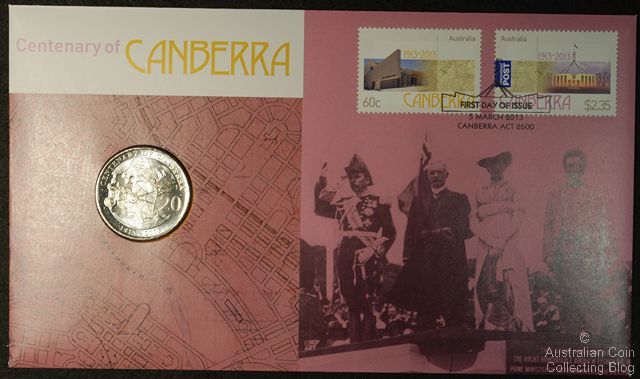
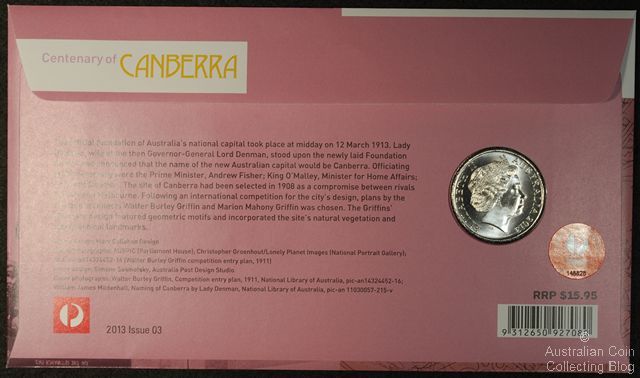
2013 Canberra Centenary 20 cent PNC


